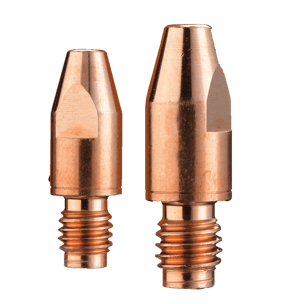Micro-arcing in a welding process are small arcs, usually not visible, that happen within the contact tip or wire liner. Instead of making a positive contact all the way through the tip, or at least always on the tip at some point, your wire is making inconsistent contact to the contact tip. This compromises current transfer and causes the wire to micro-arc inside the contact tip.
How Micro-arcing Effects the Robotic Welding Process
It's the same effect as taking automotive jumper cables connected to a battery, and touching them together. Sparks will fly, we've all seen that.
The same thing happens with micro-arcing, except it happens within the small bore of a contact tip. When that happens, the wire fuses to the interior of the contact tip.
When this happens, the typical practice is to cut off the excess wire, but by cutting it, you dislodge it off the side of the tip. While that does allow your process to get back up and running, what you've done is left a sandpaper effect where that fuse happened and built up carbon. That becomes a dead spot within the contact tip. So, even though you might still be able to weld, now you're going to get another micro-arc even faster and faster because it's building up this carbon inside.
/Blog%20Photos/How%20to%20Limit%20Micro%20Arcing%20in%20Robotic%20Welding/800x300_Robo_WH.jpg?width=800&name=800x300_Robo_WH.jpg)
To verify what you're looking at: dispense an inch of wire out of the contact tip. If it doesn't dispense, there may be an issue further into the torch.
Cut that wire off, and look at it under a magnifying glass, and you will see a spark mark. These are typically different colors than the material itself, like purples, blues, and greens. That is a clear indicator of what is physically happening when micro-arcing occurs.
How Does Micro-arcing Happen?
Your robotic welding process gets micro-arcing from three common problems:
- Lack of cast in the wire
- The inner diameter of the tip is too large
- The outer diameter in the wire is too small
Lack of Wire Cast
/2019/Boletines%202019/Bolet%C3%ADn%2013/Alambre%20cobrizo.png?width=253&name=Alambre%20cobrizo.png) It's common for manufacturers to add wire straighteners to the back of their wire feeders to straighten out the wire. If you're trying to stay consistent on where your wire's placed on the part, then a wire straightener is a nice addition to the process that can help.
It's common for manufacturers to add wire straighteners to the back of their wire feeders to straighten out the wire. If you're trying to stay consistent on where your wire's placed on the part, then a wire straightener is a nice addition to the process that can help.
However, wire straighteners have a downside of removing the cast completely out of your wire. This causes a whole other set of issues with micro-arcing because now you don't have cast to make constant contact with your contact tip.
That's why typically, if possible, I usually don't recommend using a wire straightener.
Cast in the wire is a difficult balance within a robotic welding process. Have too little, and you're certain to cause micro-arcing. Have too much, and your welding consumables are sure to wear faster. You have to decide what's more important to your operation; cost of reworking parts or cost of consumables.
Another way to limit micro-arcing from a lack of wire cast is to use horizontal spools instead of barrels because they naturally have better cast.
Inner Diameter of the Contact Tip is Too Large
 For many manufacturers, making changes to the wire isn't possible because the wire type is specified by the welding specifications. So if wire cannot be altered or changed in any way, the other method of limiting micro-arcing is to use a tight tolerance contact tip.
For many manufacturers, making changes to the wire isn't possible because the wire type is specified by the welding specifications. So if wire cannot be altered or changed in any way, the other method of limiting micro-arcing is to use a tight tolerance contact tip.
If the wire isn't good, it may not pass dimensions properly. Sometimes it's easier to simply switch contact tips.
Tight tolerance contact tips have less tolerance than standard contact tips, which provide for greater contact with the welding wire, providing better current transfer - and hence less micro-arcing.
These style of contact tips are a little more expensive because of the additional quality assurance they need to go through to meet specification, but they can solve for both the issue of lacking cast in the wire and getting more life out of the welding consumables in the welding cell.
Outer Diameter of the Wire is Too Small
When the outer diameter of the wire is too small, you encounter the same issue as the contact tip's inner diameter being two small. The two are intricately related.
Remember, the cause of micro-arcing is the cast of that wire not coming into contact with the contact tip as it's feeding out into the arc. Too large a tip diameter means the wire doesn't come in consistent contact, and too small a wire diameter produces the same effect.
/2019/Boletines%202019/Bolet%C3%ADn%2013/Alambre%20Bedra.jpg?width=300&name=Alambre%20Bedra.jpg) Wire, like contact tips, have little variances and tolerances within the specified diameter. Sometimes a spool can be slightly out of tolerance, but combine with a contact tip that's also out of tolerance, micro-arcing is sure to occur.
Wire, like contact tips, have little variances and tolerances within the specified diameter. Sometimes a spool can be slightly out of tolerance, but combine with a contact tip that's also out of tolerance, micro-arcing is sure to occur.
Welding operators who use an undersized or oversized wire to feed through the wire liner are inviting micro-arcing into their welding process. That's a more common practice among manual welding, but it's been observed plenty of times in robotic weld cells. It's not recommended and is a certain to cause micro-arcing at some point.
Make sure your wire size and contact tip size are matched up. If you still get micro-arcing after verifying they match, first go to the tight tolerance contact tips. If that doesn't help solve the problem, the wire is going to have to be the next component evaluated.

